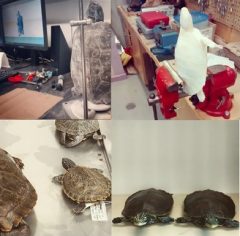When the first rains arrive in the forests of northwest Costa Rica, yellow toads gather in the hundreds for an intense but short-lived breeding season. This year, however, they will be joined by a handful of intruders called “RoboToads.” These motorized amphibians—3D printed in a lab—could help uncover the secrets behind the real toads’ unusual mating ritual. And that’s just one of many mysteries that 3D-printed animals are starting to reveal.

Back in Canada, biologist Grégory Bulté, of Carleton University in Ottawa, is using 3D printing to answer a question that’s been bugging him for more than a decade. Bulté studies northern map turtles, whose females can grow to twice the length of males. He wondered whether males might be attracted to larger females, but the turtles’ skittish nature—and the fact that they mate on the floor of the lake—made observation tricky.
Bulté’s team printed two 3D models of female turtles, identical in every aspect except size, and placed them a meter apart on the lakebed, with cameras rigged up to record how wild males reacted.
Watch male and female northern map turtles interacting with 3D printed decoys in the field:
The Biology Team consisted of:
See full article here:
Here’s what happens when you replace toads and turtles with 3D-printed replicas in the wild
By Matt Warren